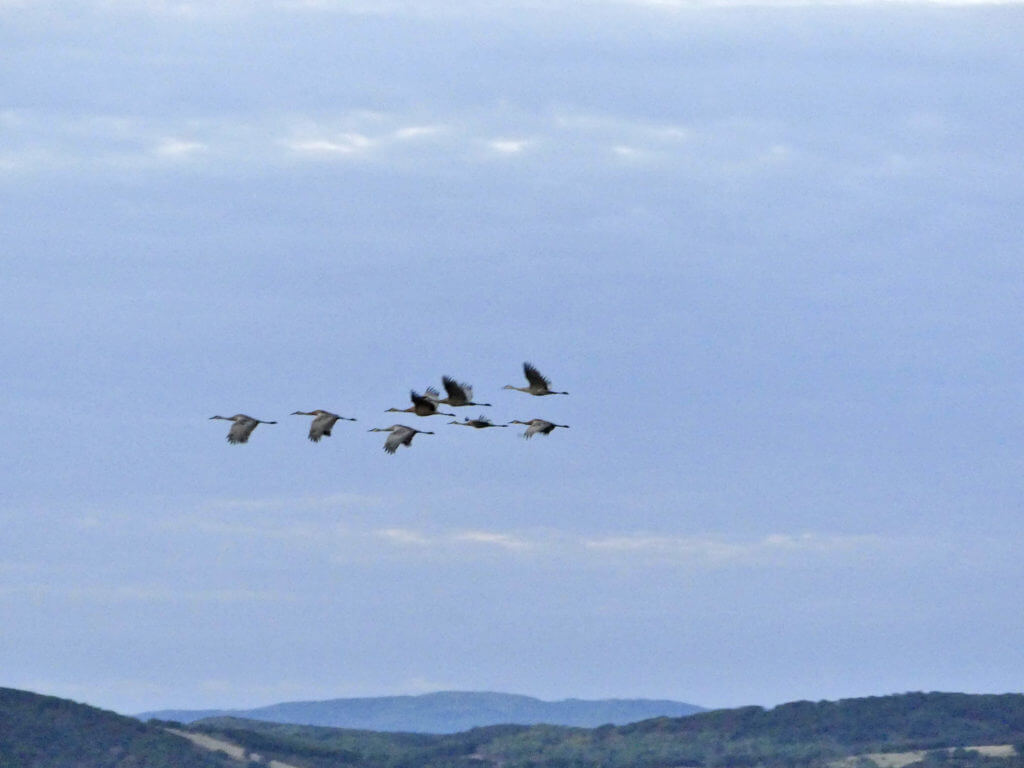Cranes in the ‘hood

In recent years sandhill cranes have been observed in Vermont. So, what’s the big deal?
Well, among other things, sandhills (Antigone canadensis) are the oldest species of bird on earth; fossil records date them to about ten million years. And cranes can dance! Considered the most accomplished dancers in the animal kingdom (other than people), adults teach their chicks, called colts, to dance when they are only a few months old. Juveniles practice for several years before choosing a mate. Dancing can be a means of expressing excitement or frustration, releasing pent-up energy, and courtship. Cranes announce their presence far and wide—their penetrating call can carry up to one mile.
Spectacular in flight, with long necks and legs extended beneath a six-foot wingspan, cranes can soar on air currents to 15,000 feet. These gray-feathered birds stand up to five feet tall and sport a white neck and red crown. Yet in their courtship plumage cranes appear rust colored. This coloring is not natural; the birds paint themselves each year with rust-laden mud that transforms their plumage. This rusty color helps camouflage them during mating and incubation. When they molt each summer cranes again turn gray until their mud bath the following spring.
Cranes are long lived and generally mate for life, returning to the same nesting area every year. In Colorado’s Yampa Valley the Sandhill population includes one banded couple that has remained together for 26 years and a 41-year-old bird!
Cranes have only three functioning toes and thus cannot clasp branches that would allow them to nest in trees (like herons). Instead they seek protection from mammalian predators—coyotes, wolves and raccoons—by nesting and sleeping in or at the edge of water and wetlands. Nests are heaps of weeds and wetland plants. The female usually lays two eggs, and the parents take turns incubating them for three to four weeks. Once the chicks hatch they grow at an astounding rate of a half to one inch per day, learning to dance in their second month. By the end of summer juveniles must be able to fly up to 500 miles a day and soar over the Rocky Mountains on their fall migration.
Back to Vermont: A pair of sandhills settled in Bristol in 2005 and in 2007 successfully fledged a chick. In 2013 a second pair was seen consistently in Fairfield and confirmed to have bred. To date there are no 2018 sightings, but in recent years a singleton or a pair have been spotted in Franklin, Brandon, Bristol Pond and on the ridge between West Rutland and Proctor. On Earth Day in 2016 Chris Rimmer, an ornithologist and executive director of the Vermont Center on Ecostudies, stumbled upon an unexpected gift: a family of cranes on the grounds of the state prison in Windsor.
Why would sandhills visit Vermont? With the climate changing, and water and food supplies altering as a result, the range of cranes may be shifting to the Northeast. Cranes are omnivores, but they prefer to bulk up on grains like corn, barley and wheat, before their fall migration. With western states becoming drier many farmers are shifting from growing crops to grazing animals. Eastern flyways host fields of corn and other grains, and Vermont is no exception. With pairs now also nesting in New Hampshire, Maine, New York and western Massachusetts, it is not clear if this recent influx of sandhill cranes represents a range expansion or recolonization of the species’ historic range.
One way or another keep your eyes and ears open for this unusual and extraordinary sight.

